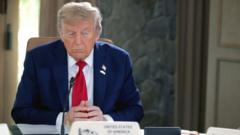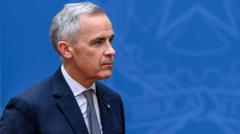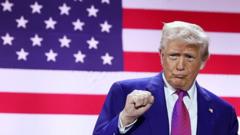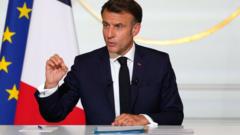With conflicting information on rates, affected countries, and overall economic impact, analysts and businesses alike are grappling with the potential consequences of President Trump's upcoming tariffs announcement.
Unraveling the Uncertainties of Trump's 'Liberation Day' Tariffs

Unraveling the Uncertainties of Trump's 'Liberation Day' Tariffs
As President Trump gears up to unveil new tariffs under the banner of "Liberation Day," the global community watches closely for crucial details on when and how these measures will be implemented.
Donald Trump is set to announce a new wave of tariffs, gathering global attention and raising critical questions amidst uncertainty. Dubbed "Liberation Day" by the White House, this initiative has sparked varying opinions and speculation about the potential scale and scope of the impending measures.
The administration has not yet disclosed what the specific tariffs will be, leading analysts to conjecture possible rates. On the campaign trail, Trump mentioned a 10% blanket tariff on all incoming imports to the US, with considerations of increasing it to a range of up to 60%, especially for Chinese imports. He has also put forward the concept of "reciprocal" tariffs, which might apply differently depending on each country's charges on US products. However, suggesting that tariffs will also encompass policies some deem unfair, such as Value Added Tax (VAT), has introduced a layer of complexity.
This cloud of uncertainty has spurred a rush among business leaders and political figures to ascertain how the new taxes may affect their industries, especially as they interact with existing tariffs, including those on steel and aluminum. European officials are bracing themselves for potential double-digit tariffs on exports to the US, with Trump hinting at a 25% tax on goods from the European bloc.
As the specific countries affected remain unannounced, speculation mounts around the extent of the tariffs' application. The potential for an across-the-board tariff has quashed hopes in nations like the UK, although a deal is still not off the table. Attention has centered on a select group of countries, including Canada, China, and the EU, which have received pointed remarks from Trump, emphasizing his belief that allies can impose harsher tariffs than adversaries.
The implications of these tariffs extend beyond import taxes; ultimately, the biggest question revolves around who will bear the burdens of these costs. While US firms importing these goods will face the direct financial impact, many may opt to pass on their elevated expenses to consumers, resulting in higher prices. However, this could drive buyers away, creating a precarious balance.
Preparing for the fallout, companies are already strategizing alternatives, such as changing suppliers or seeking partnerships to mitigate costs. Yet, the complexity of the global economy, with currency fluctuations and the potential for retaliation from other nations, further complicates the aftermath of this significant announcement.
As Trump’s team readies the unveiling of these tariffs on Wednesday, both domestic and international stakeholders remain on edge, aware that the future of US trading relationships hangs in the balance.





















